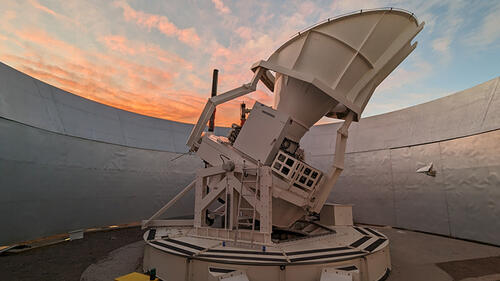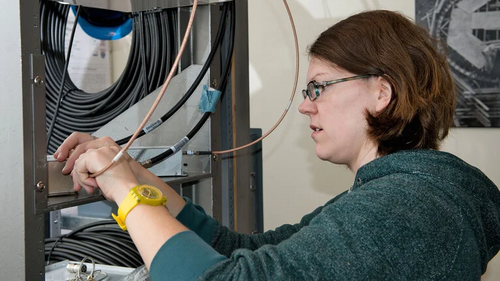
Special software designed, built, and tested at Yale is crucial to the success of the new Simons Observatory in Chile.
Whether she’s shuttling between meetings at Yale’s Wright Lab or conferring with colleagues around the world, Laura Newburgh’s thoughts of late rarely stray far from the Simons Observatory in northern Chile.
The new, $110 million observatory — funded by the nonprofit Simons Foundation and the National Science Foundation — will test whether the universe experienced a massive growth spurt in the instant after the Big Bang. The observatory features four telescopes with more than 30,000 individual detection devices and offers an unprecedented scientific opportunity to probe the primordial light known as the cosmic microwave background (CMB).
But it won’t be able to do its work without software designed, built, and tested by Newburgh and her team at Yale.

“It’s an incredibly ambitious experiment,” said Newburgh, an assistant professor of physics in Yale’s Faculty of Arts and Sciences and member of the observatory’s technical community. “We’ll make the most precise measurements of the infant universe and might even capture the physics of an elusive period when the universe was less than a second old.”
Yale News caught up with Newburgh recently to talk about her work at the observatory and the fundamental questions that may be answered there. The interview has been edited and condensed.
Let’s start with the Cosmic Wave Background, which this project is exploring. What is it and what do we know about it?
Laura Newburgh: Essentially, it is microwave light that is present across the entire sky, and represents the first light produced by the universe, when it was about 400,000 years old. This was long before stars and galaxies existed, so it is primordial plasma of interacting particles.
Measurements of the CMB have been around since the 1960s. They’ve told us about our universe — including its shape, age, and what is in it — by providing evidence for the existence of dark energy and dark matter. Those experiments were often done by small teams of people coming together and building instruments in their own labs. The scale of the experiments has gotten bigger as our ambitions have grown, which has led to what we’re doing at Simons Observatory.
What is the science mission for Simons Observatory?
Newburgh: We have two main goals. The first is to study the universe in its most infant stage, when it was much less than one second old.
We think the universe expanded much faster than the speed of light, during a period we call ‘inflation.’ This is theorized to exist, but it hasn’t been proven. So, at the new observatory, we are going to look for a signal from this ‘inflation’ period, embedded in the CMB.
The second goal is to search for additional early particles in the universe. Around the time the CMB formed, when the universe was about 400,000 years old, it was an incredibly energetic period, with particles being produced in copious amounts. These are what we call “light relativistic particles.” Ground-based particle accelerators and other experiments can’t look for these particles — but we think we can.
Lastly, we want to do a better job of measuring some things via the CMB that we already know about, such as how the universe is expanding today.
What technology is Simons Observatory using to answer these questions?
Newburgh: Simons Observatory has built four telescopes that will do this — and we’ll be adding more telescopes in the years ahead.
What’s deployed at the site now are three small aperture telescopes whose field of view is 30 degrees — about the size of 60 moons in diameter. There are 30,000 detectors across the three telescopes, and they have been built to measure inflation in the earliest universe.
They’ll look for a specific signal within the CMB that would indicate the stretching and contracting of space that would have occurred during the inflation process.
We also have one large aperture telescope, which has been deployed, but the mirrors aren’t on it yet. That telescope that will be searching for additional particles.
I should reiterate that when we look at the CMB, we’re looking at a primordial plasma — not the stars, galaxies, and beautiful colors you think of with a regular telescope. We’re measuring plasma density. It basically looks like static.
What is Yale’s role in all of this?
Newburgh: We built the software architecture to control all of the systems on the telescopes and acquire the data from the 60,000 detectors across the observatory — a factor of four more than any other CMB experiment!
Simons Observatory will take in four times more data than any previous CMB telescope project. It is an entirely new scale of operation for this field. In addition to the detector data, this scale of observatory comes with many, many more auxiliary components that we must interact with to observe the sky. The telescopes have to move and track and scan, the calibration equipment must work seamlessly, and the detectors have to be chilled to 0.1 degrees Kelvin above absolute zero with a fancy helium refrigerator — so we are also acquiring data, and in some cases making commands, from all of these subsystems. As of last count, we have over 5,000 auxiliary sensors to read out, which also includes data visualization and alarms. This is an entirely new scale for a CMB observatory, and we had to build the system from scratch.
In addition to the scale, the truly revolutionary thing we did was making our software easy enough to use so that any of our collaborators could easily add their components to the system using just a snippet of readily available code. That is how we ended up with more than 5,000 fields.
How does your work at Simons Observatory fit into your overall body of research?
Newburgh: My thesis experiment was based seven miles away from where Simons Observatory is now in Chile’s Atacama Desert, looking for the same signature of cosmic inflation. My first graduate work also focused on the case for inflation. And my first postdoc was spent at a 6-meter telescope, looking for new particles, at literally the same site where Simons Observatory is.
What is it that drew you to this field initially?
Newburgh: On some level, I think we’re all interested in where we came from and what the universe is made of. To me, these are the most fascinating questions we can address.
I’ve been doing cosmology for a long time. I found it’s a fun marriage of experiment and theory. These groundbreaking experiments can address some of the biggest questions we have about our universe. But at its core, it’s still a group of people staring at the sky and trying to do a good job measuring its properties.
When is your next trip to Chile?
Newburgh: Hopefully soon! I signed up for going three times this year — I’m aiming for August.
This story was originally published in Yale News, July 22, 2024, by Jim Shelton. See below for the link to the original article.